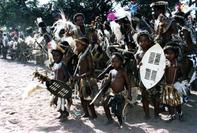Separate Clans
Around the year 1550, Malandela, a chief with a small following, settled at the foot of Amandawe Hill on the southern banks of the Umhlatuze River just before it enters the Nkwaleni Valley.

He had two sons, Qwabe and Zulu, who, according to oral tradition, constantly squabbled with one another, and so Malandela sent Qwabe to live along the lower reaches of the river, somewhere near present-day Empangeni, and Zulu was sent north to settle in the region of the White Umfolozi River. In due course, both brothers consolidated their followings into separate clans, and both paid separate tribute 'ukukhonza' to the Mthethwa chief, who was the most powerful in the region.
Dingiswayo of Mthethwa
Towards the end of the 18th century, Dingiswayo became the chief of the Mthethwa. As a young man, he had had to flee for his life, as his father suspected he was plotting to overthrow him. Dingiswayo travelled extensively throughout the region of what is today known as KwaZulu-Natal.
Through his travels, his vision was broadened and he was introduced to trading, which was growing steadily around the Portuguese port of Delagoa Bay When he heard about the death of his father, he returned on horseback, carrying a gun, to take over the leadership of the Mthethwa.
Dingiswayo was a shrewd and powerful leader who recognized that competition for land and natural resources were becoming more and more intense and that ability to dominate trade with the Portuguese would bring distinct advantages. Thus he saw that building up the Mthethwa army and his following was increasingly important. To this end, he set about systematically amalgamating into a single polity the loosely structured groups that paid tribute to him, and absorbing those whom he defeated in combat.